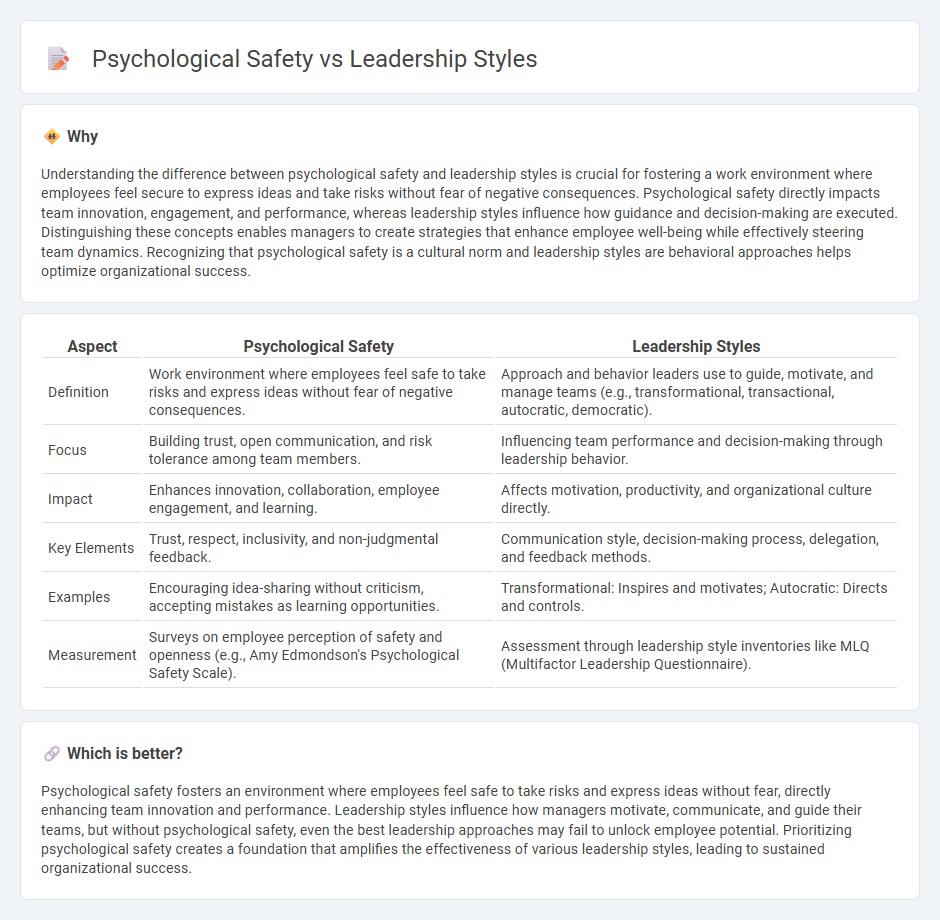
Psychological safety fosters an environment where employees feel secure to express ideas and take risks without fear of negative consequences, crucially influencing team performance and innovation. Various leadership styles, from transformational to servant leadership, significantly impact the level of psychological safety within organizations. Explore how aligning leadership approaches with psychological safety principles can enhance workplace culture and productivity.
Why it is important
Understanding the difference between psychological safety and leadership styles is crucial for fostering a work environment where employees feel secure to express ideas and take risks without fear of negative consequences. Psychological safety directly impacts team innovation, engagement, and performance, whereas leadership styles influence how guidance and decision-making are executed. Distinguishing these concepts enables managers to create strategies that enhance employee well-being while effectively steering team dynamics. Recognizing that psychological safety is a cultural norm and leadership styles are behavioral approaches helps optimize organizational success.
Comparison Table
| Aspect | Psychological Safety | Leadership Styles |
|---|---|---|
| Definition | Work environment where employees feel safe to take risks and express ideas without fear of negative consequences. | Approach and behavior leaders use to guide, motivate, and manage teams (e.g., transformational, transactional, autocratic, democratic). |
| Focus | Building trust, open communication, and risk tolerance among team members. | Influencing team performance and decision-making through leadership behavior. |
| Impact | Enhances innovation, collaboration, employee engagement, and learning. | Affects motivation, productivity, and organizational culture directly. |
| Key Elements | Trust, respect, inclusivity, and non-judgmental feedback. | Communication style, decision-making process, delegation, and feedback methods. |
| Examples | Encouraging idea-sharing without criticism, accepting mistakes as learning opportunities. | Transformational: Inspires and motivates; Autocratic: Directs and controls. |
| Measurement | Surveys on employee perception of safety and openness (e.g., Amy Edmondson's Psychological Safety Scale). | Assessment through leadership style inventories like MLQ (Multifactor Leadership Questionnaire). |
Which is better?
Psychological safety fosters an environment where employees feel safe to take risks and express ideas without fear, directly enhancing team innovation and performance. Leadership styles influence how managers motivate, communicate, and guide their teams, but without psychological safety, even the best leadership approaches may fail to unlock employee potential. Prioritizing psychological safety creates a foundation that amplifies the effectiveness of various leadership styles, leading to sustained organizational success.
Connection
Psychological safety in management is crucial for fostering open communication and innovation, directly influenced by leadership styles such as transformational and servant leadership. Leaders who promote empathy, trust, and support create an environment where employees feel safe to express ideas and take risks without fear of negative consequences. This supportive climate enhances team performance, employee engagement, and organizational learning.
Key Terms
Transformational Leadership
Transformational leadership significantly enhances psychological safety by fostering trust, open communication, and a supportive work environment, encouraging employees to express ideas without fear of negative consequences. This leadership style emphasizes inspiration and motivation, which cultivates a culture of collaboration and innovation crucial for team performance and employee well-being. Explore how transformational leadership can be leveraged to improve psychological safety and drive organizational success.
Inclusive Leadership
Inclusive leadership fosters psychological safety by encouraging diverse perspectives and creating an environment where team members feel valued and trusted. This leadership style reduces fear of judgment or negative consequences, promoting open communication and collaboration. Explore how inclusive leadership can transform workplace culture and enhance team performance.
Trust
Leadership styles directly influence psychological safety by shaping the level of trust within a team; transformational and servant leadership tend to foster higher trust through empathy and support. Trust acts as a critical mediator, enabling open communication and risk-taking, which enhances innovation and team performance. Explore how different leadership approaches can build or hinder trust to improve psychological safety in your organization.
Source and External Links
What Is Leadership: Understanding Different Leadership Styles - Leadership styles are approaches leaders take to guide and motivate teams, including autocratic (decisive and rule-oriented), democratic (inclusive and participative), with each having distinct benefits and challenges based on context.
How to Determine What My Leadership Style Is - Leadership styles vary in focus from democratic, which emphasizes team collaboration and inclusiveness, to laissez-faire, which involves hands-off management and autonomy for team members.
6 Common Leadership Styles -- and How to Decide Which to Use ... - Six versatile leadership styles include coercive, authoritative, pacesetting, affiliative, democratic, and coaching, and effective leaders adapt their approach depending on the situation and team needs.
 dowidth.com
dowidth.com